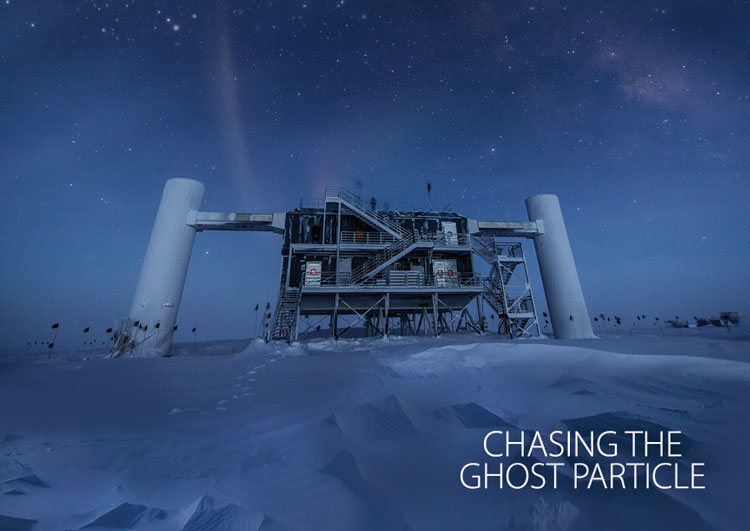
Madison/Milwaukee (Nov 18, 2013) – Get ready for a journey you will never forget. The fulldome planetarium show Chasing the Ghost Particle: From the South Pole to the Edge of the Universe will open at the Milwaukee Public Museum’s Dome Theater on November 21, 2013, at 7:30 p.m. The show takes audiences on an amazing 30-minute trip from the most extreme places in the universe to inside the IceCube telescope, a huge detector buried deep in the Antarctic ice.
IceCube is designed to chase neutrinos coming from the distant universe. Neutrinos are extremely small particles that are almost undetectable, earning them the nickname “ghost particles.” They are expected to give us new information about some of the most powerful environments in the cosmos, expanding our understanding of black holes and exploding stars beyond what we have obtained from other types of telescopes.
Chasing the Ghost Particle is a joint production of the Wisconsin IceCube Particle Astrophysics Center (WIPAC) at the University of Wisconsin–Madison and the Milwaukee Public Museum (MPM). The premiere is open to everyone and features an introduction by Prof. Francis Halzen, principal investigator of the IceCube project and the Hilldale and Gregory Breit Distinguished Professor of Physics at UW–Madison. Prof. Halzen first proposed the detection of neutrinos in ice in the late 1980s, and led the team that made this titanic project a reality. More information about the premiere and upcoming showings can be found at www.mpm.edu/ghost-particle.
“After years of effort, involving hundreds of people from Wisconsin and more nationally and internationally, we knew IceCube was a great story that we had to share,” explains Jim Madsen, associate director for education and outreach at WIPAC. “The show explains the birth of a new kind of astronomy, looking at our universe with neutrinos rather than light. The good news is that it all works even better than we expected. And we are hoping for new discoveries about our universe to be announced very soon,” adds Prof. Madsen, who also chairs the Physics Department at UW–River Falls.
Chasing the Ghost Particle will be shown at MPM on Thursdays at 5:30 and 6:30 p.m. through January 30, 2014, and will be available for schools through at least 2016. A Madison premiere is planned for January 2014. The event will begin with an introductory talk by Albrecht Karle, IceCube associate director for science and instrumentation.
The IceCube detector is comprised of 5,160 digital optical modules suspended along 86 cables embedded in a cubic kilometer of ice beneath the South Pole. The telescope detects neutrinos through tiny flashes of blue light, called Cherenkov radiation, produced when neutrinos interact in the ice.
The IceCube Neutrino Observatory was completed in December 2010 after seven years of construction. It was built under an NSF Major Research Equipment and Facilities Construction grant, with assistance from partner funding agencies around the world. WIPAC is the lead organization for IceCube, responsible for maintaining and operating the detector to maximize data quality and output.
Show overview
From a close collaboration between WIPAC and MPM, the Daniel M. Soref National Geographic Dome Theater and Planetarium will premiere Chasing the Ghost Particle, a 30-minute show that allows audiences to travel from the most extreme places in our universe to inside the IceCube detector at the South Pole.
The story begins in deep space, billions of years ago. Extreme conditions, such as black holes and exploding stars, created very high-energy neutrinos that travel unaffected across galaxies and even through stars. At the South Pole, a team of scientists and technicians built the IceCube Neutrino Observatory to catch some of these neutrinos and learn about the most powerful engines in the universe.
IceCube is a prime example of the longstanding human passion for exploration and discovery. Neutrinos, one of the lightest particles of matter that we know of, are opening a new age in astronomy. Audiences will learn how we can get unique information and new insights about our universe. Tiny neutrinos are the cosmic messengers that travel from exploding stars and black holes to IceCube, buried more than two kilometers deep in the Antarctic ice sheet.
Neutrinos are difficult to detect because they are absolutely invisible unless they interact with matter, which rarely happens. If we made a neutrino detector the size of a person, it would take 100 years to find any neutrinos, and 100,000 years to find a high-energy neutrino like those measured by IceCube. But trillions pass through a person each second unnoticed—that’s why they were dubbed “ghost particles.” They are everywhere, but IceCube is able to detect the highest energy neutrinos, giving us the opportunity to explore the cosmos as we have never done before.
Where to see it
Chasing the Ghost Particle: From the South Pole to the Edge of the Universe can be seen at the Dome Theater at the Milwaukee Public Museum. MPM is located at 800 W. Wells St., Milwaukee, WI 53233.
Showtimes:
5:30 and 6:30 p.m. Thursday, December 5
5:30 and 6:30 p.m. Thursday, December 12
5:30 and 6:30 p.m. Thursday, December 19
5:30 and 6:30 p.m. Thursday, December 26
5:30 and 6:30 p.m. Thursday, January 2
5:30 and 6:30 p.m. Thursday, January 9
5:30 and 6:30 p.m. Thursday, January 16
5:30 and 6:30 p.m. Thursday, January 23
5:30 and 6:30 p.m. Thursday, January 30
Tickets can be purchased at the Milwaukee Public Museum, in advance by phone at (414) 319-4629 or online at www.mpm.edu.
Bob Bonadurer, Director of Theater and Planetarium, Co-director of Chasing the Ghost Particle, Bonadurer@mpm.edu
Jim Madsen, Associate Director for Education and Outreach, Co-director of Chasing the Ghost Particle, james.madsen@uwrf.edu
